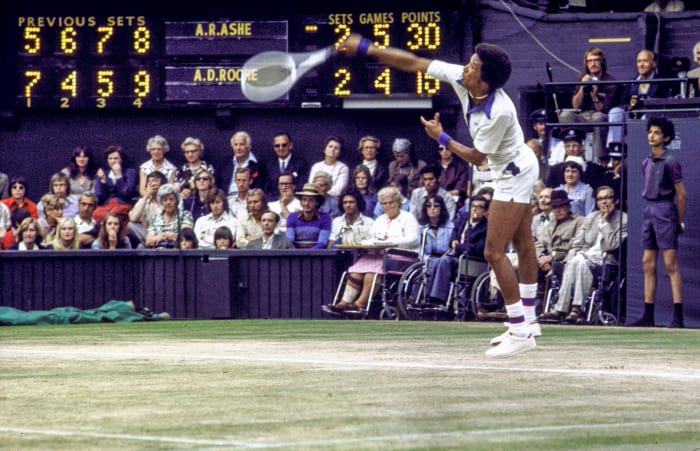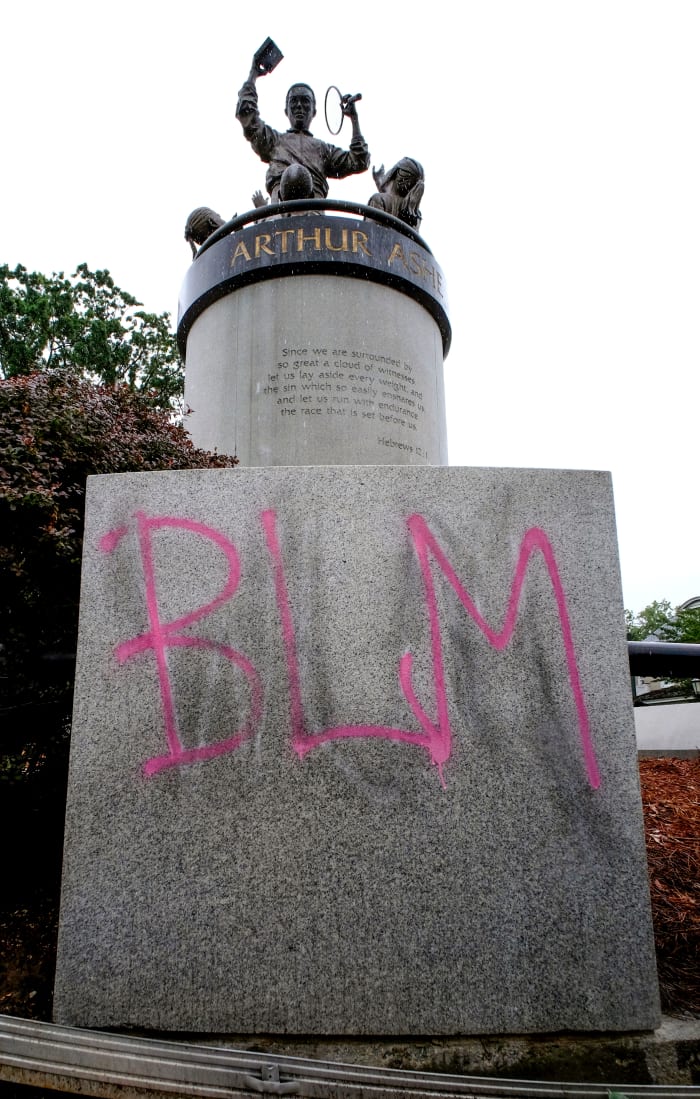Where the Confederates Fell, Arthur Ashe Still Stands
When Arthur Ashe was a boy, few places were as rigidly segregated in his hometown of Richmond as the city’s tennis courts. In the summer of 1952, when Ashe was nine and already showing promise as a tennis player, he participated in several tournaments at Black parks around the city. But when the future U.S. Open and Wimbledon champion attempted to register for a youth tournament at Byrd Park, a facility for white people, he was turned away.
During Ashe’s childhood, Jim Crow remained the law of the land across the South. For Black residents of Richmond, reminders of second-class citizenship were everywhere. "When I decided to leave Richmond," Ashe wrote in his 1981 autobiography, "I left all that Richmond stood for at the time—its segregation, its conservatism, its parochial thinking, its slow progress toward equality, its lack of opportunity for talented black people.”
And no place reinforced the racial hierarchy of the city like Monument Avenue. Within the 1 ½ -mile historic district of this tree-lined residential street, long a desirable residential address for wealthy Richmonders, stood five monuments to men who fought to keep Ashe’s ancestors enslaved.
It was unfathomable then that these statues might ever come down. But it was even more unfathomable that a statue of a Black man—someone who, until 1962, couldn’t play tennis at Byrd Park—would join, and then outlast them. But in the summer of 2020, amid a nationwide reckoning over racism after the murder of George Floyd, protesters set their sights on Richmond’s Confederate monuments and all that they stood for. One by one, the old rebels came down, surrendering, not for the first time, to forces seeking racial progress. Just blocks away, a bronze likeness of Arthur Ashe—the only winner on Monument Avenue—quietly smiled, beckoning a better future.
On a balmy day in May 1890, more than 100,000 people gathered in Richmond to see a larger-than-life hero. Robert E. Lee had died 20 years earlier, and his deification among Southerners—white Southerners, that is—had only intensified since. That day, in the former capital of the Confederacy, a 21-foot-tall, 12-ton colossus of the general on horseback was unveiled. The statue, crafted in Paris by the French sculptor Antonin Mercié, would soar 61 feet into the Virginia sky once placed on its granite pedestal. “A people carves its own image in the monuments of its great men,” began Archer Anderson’s oration that day. Implied was that Lee represented the collective, a claim refuted by John Mitchell Jr., the editor of the Black newspaper Richmond Planet. “The Negro was in the Northern processions on Decoration Day [Memorial Day] and in Southern ones, if only to carry buckets of ice-water,” Mitchell wrote. “He put up the Lee Monument, and should the time come, will be there to take it down.”
The statue was part of a boom of new monuments unparalleled in U.S. history. In the years after the Civil War, as the nation reckoned with a conflict that had radically reshaped the country’s social structure and the very concept of freedom, memorials to generals, political leaders and soldiers blossomed across the nation like magnolia. These monuments colored the country’s memory with irresistible hues of military valor and sectional reconciliation—a narrative that almost always left out slavery, not to mention the freedom won by millions of Black people. For both Northern and Southern white people, as the Yale historian David Blight has documented, healing outweighed justice, allowing an insidious pro-Confederate account of the conflict, the Lost Cause, to take root. In Richmond, too, it was the beginning of an era of statue construction that would anchor a new grand boulevard. Virginia Governor Fitzhugh Lee’s chosen location for the statue of his uncle wasn’t the state capitol, where other major public sculptures had gone, but rather an undeveloped parcel of farmland on the outskirts of the city—“surely,” as Henry James observed, “the most bizarre location ever chosen for a Beaux-Arts-designed monument.”
The land was owned by a local businessman who intended to create a new high-end neighborhood surrounding the planned monument. As the city expanded westward and formally annexed the land, Monument Avenue became the home of Richmond’s new elites—not the plantation owners and planters who dominated the state’s antebellum economy, but the merchants, lawyers and industrialists who formed the upper class of one of the New South’s leading economic centers.
Over the next 35 years, other bronze tributes to the heroes of the defeated Confederacy would join Lee on an expanding Monument Avenue: Generals Stonewall Jackson and J.E.B. Stuart, President Jefferson Davis and naval officer (and pioneering oceanographer) Matthew Fontaine Maury. All of these men waged war against the United States to preserve the institution of slavery. But on the stately grounds of Monument Avenue, they were recast as heroes. The building spree, coinciding with an era of widespread white supremacist violence and discrimination under the law, was part of a campaign by white Southerners to reimagine the war as a noble undertaking, fought not over slavery but over state sovereignty. The Lost Cause, as this myth—and other pernicious fictions, such as the fable of the content slave—became known, is perhaps the most consequential lie in U.S. history. And in Richmond, and across the South, it was deployed to reinforce the old racial order.
“It’s really about putting forward a set of ideas that rationalize slavery 2.0,” says University of Richmond historian Julian Hayter. “These people have to find a way to reorganize government and society to maintain oligarchy. The controlling of public space becomes a mechanism with which they set out to do that, and that’s what Monument Avenue really represents.”
When Ashe was born in 1943, the foundation of white supremacy on which those statues were built remained strong. But those statues weren’t merely symbolic, either. Black Richmonders weren’t welcome on Monument Avenue, certainly not as homeowners: Restrictive covenants ensured, as one real estate company assured potential buyers, that “no lots can ever be sold or rented in MONUMENT AVENUE PARK to any person of African descent.” The city also passed several ordinances formally codifying segregation, including one that banned people from residing in a neighborhood where they were disallowed from marrying a member of the racial majority (ie, a Black person could not move to a white neighborhood, since anti-miscegenation laws persisted until Loving v. Virginia in 1967). Many Black people worked in the elegant homes that lined Monument Avenue, but they were confined to back alleys and servants’ entryways.
To Black Richmonders, Jim Crow laws and Lost Cause statues offered a clear message: keep out. That message wasn’t lost on Arthur Ashe, who drove his wife, Jeanne Moutoussamy-Ashe, down the street on a visit to Richmond for a family reunion in the 1970s.
“He told me the stories of how he wasn’t allowed to ride his bike or walk down Monument Avenue when he was a kid,” Moutoussamy-Ashe recalls. “I just remember seeing these big homes. … I could understand how that made him uncomfortable. It made me uncomfortable.”
By then, Ashe was a U.S. Open and Wimbledon champion. Statutory Jim Crow had been eradicated by the civil rights movement, which had spurred so-called “massive resistance” by Virginia’s state government and even a movement to build new Confederate statues on Monument Avenue in response to Black gains. Those plans, including a proposal by the Spanish surrealist painter Salvador Dalí to build a statue of Confederate hospital administrator Sally Louisa Tompkins, never materialized. But even after Richmond elected a majority-Black city council in 1977, heralding a new era of racial progress, Monument Avenue still “functioned within the civic landscape as a last bastion of white privilege,” as the art and architecture historian Kirk Savage puts it in his book Standing Soldiers, Kneeling Slaves: Race, War, and Monument in Nineteenth-Century America. That was about to change.
At the 1968 U.S. Open, Arthur Ashe was one of 128 men in the draw—and the only African American. A Black man in a white sport, he felt “as noticeable as the only raisin in a rice pudding.”
Ashe, still an amateur, famously ended up winning the tournament, which was the first U.S. Open to feature professional players. Ashe became the first Black man to play for the United States Davis Cup team, and the first to win the U.S. Open, Australian Open and finally Wimbledon, in 1975, defeating compatriot and defending champion Jimmy Connors in the final. His four-set victory, a tactical master class, was a moment of undeniable significance for tennis, made even more remarkable with a wide lens into the past.
“Think of it this way, in the historical sense: The progeny of English aristocrats create tennis, but they also create a slave system across the Atlantic designed to dehumanize the ancestors of people like Arthur Ashe,” Hayter says. “Isn’t it ironic, then, that he goes back into a space created by those very aristocrats and beats them at their own game? That’s his f------ legacy. ”
For Ashe, climbing to the top of tennis meant navigating a world as white as Wimbledon’s dress code. And despite the discrimination he faced, Ashe became the first Black man to be ranked No. 1 by the United States Lawn Tennis Association. He also evolved into one of the 20th century’s most influential athlete activists, advocating not just for equality in the U.S. but also notably in South Africa, where during a famous 1973 visit he “looked apartheid directly in the face, saw the appalling WHITES ONLY and NONWHITES ONLY signs, the separate and drastically unequal facilities very much like those of my childhood in Virginia,” according to his 1994 memoir, Days of Grace. He was arrested in ’85 during a demonstration in front of the South African embassy in Washington, D.C.; he was arrested again in ’92 outside the White House protesting the mistreatment of Haitian refugees. By then, Ashe had announced he had contracted HIV through a blood transfusion during heart surgery. That year, he formed the Arthur Ashe Foundation for the Defeat of AIDS, addressing the United Nations General Assembly on World AIDS Day, and was named Sports Illustrated’s Sportsman of the Year, more than a decade after his retirement from tennis.
Shortly after his HIV announcement, Ashe was back in Virginia, preaching the power of education to a group of children at a tennis clinic. Paul DiPasquale, a Richmond sculptor who happened to be there after driving his daughter and some other kids to the courts, heard Ashe speak and came away impressed by his vision for improving young lives. It was a chance encounter that would eventually lead back to Richmond’s most exclusive avenue.
When DiPasquale first pitched Ashe on his idea to create a sculpture of the tennis great, Monument Avenue wasn’t on anyone’s mind. The idea was to place the sculpture at the African American Sports Hall of Fame, a physical manifestation of Ashe’s book A Hard Road to Glory. At the time, Richmond was attempting to secure funding for the Hall of Fame, and Ashe was open to the idea of a statue. “In a limited but significant way, he reasoned, the statue might enhance a positive legacy in his hometown,” Raymond Arsenault wrote in his 2018 biography of Ashe. “The imagery had to be just right, however—a representation of his ideals, something that would communicate his faith in education, equality, and active citizenship.”
In early 1993, Ashe phoned DiPasquale and gave the artist his approval to create a statue of his likeness. He didn’t, however, want to be the center of attention—a difficult request, as DiPasquale gently pointed out, given that his representation of Ashe was going to be a 12-foot figure. Ashe told the artist that he’d like books and children to be involved in the concept, a message that “knowledge is power.” He also wanted to be portrayed in his tennis warmup clothes, with his shoes untied. “I suppose,” Ashe added, “a tennis racket should be in there somewhere.”
Ashe said he’d send pictures. DiPasquale said he’d send drawings. The conversation lasted around 10 minutes.
A few weeks later, Arthur Ashe died of complications from AIDS at age 49. Before he entered the hospital for the last time, he sent DiPasquale a package of photos.

Ashe serves during the final set of his semifinal match of the 1975 Championships.
Tony Triolo/Sports Illustrated
Ashe’s death gave new urgency to Richmond’s desire to honor its native son. But Ashe’s Hard Road to Glory African American Sports Hall of Fame never got off the ground, despite the effort of executive director Harrison Wilson III, the father of future NFL quarterback Russell Wilson. DiPasquale, meanwhile, was still intent on finishing his statue—he just needed funding and a place to put it.
In 1994, after Richmond’s Ashe Memorial Committee and City Council approved the project, Virginia Heroes—Ashe’s mentorship program that connected sixth-graders with mentors—announced a $400,000 fundraising campaign for the project. The chairman at the time was former Virginia Governor L. Douglas Wilder, the first elected Black governor in U.S. history and a longtime friend of Ashe. During a public ceremony unveiling DiPasquale’s plaster version of his creation, Wilder announced his preference for the statue’s location: Monument Avenue.
“I thought it was a bad idea,” DiPasquale recalls, as he felt “the chances of success were slim. The purpose was to honor Arthur Ashe and not to make it a fight.”
It was an extraordinarily controversial idea, and opposition was fierce. Some white people strongly opposed the idea of adding a Black man to the city’s famed row of Confederate statues, and they expressed that opposition in both veiled and not-so-veiled terms. (At one City Council meeting, the president of a local group that promoted Confederate flag displays called Monument Avenue “hallowed ground” and said placing Ashe there would violate “the historic sensibilities of Richmond's Confederate-American population." ) Many of Richmond’s Black residents also opposed placing Ashe on “Losers’ Lane”—Ashe, they reasoned, shouldn’t be equated with traitors who fought to preserve slavery.
But the idea gained traction. Proponents argued that if Monument Avenue purported to be a “Boulevard of Heroes,” then Ashe belonged. Richmond Times-Dispatch columnist Michael Paul Williams strongly championed Ashe’s placement on the avenue. “The idea of a taxpayer-supported boulevard populated by a bunch of white supremacists and the idea that that street would forever be reserved for these Confederates, for men who fought to perpetuate the enslavement of my ancestors, did not sit well with me,” Williams recalls.
As for a proposal to place Ashe at Byrd Park, where he was famously turned away as a boy, Williams felt it would too narrowly classify Ashe as a tennis player instead of portraying him as the polymath he had become. Plus he knew the city wouldn’t allow a Monument Avenue statue to fall into disrepair.
At a contentious seven-hour public hearing on July 17, 1995, the City Council considered the Monument Avenue site. The meeting was packed with supporters and opponents, some wearing Confederate garb. More than 100 people spoke. The council, including future Democratic Senator Tim Kaine, voted 7–0 (with one abstention) to place the statue at the intersection of Monument Avenue and Roseneath Road, three blocks west of Matthew Fontaine Maury. Chuck Richardson, a Black councilman and one of the site’s staunchest supporters, called the vote “a symbolic move forward for Richmond and for America.”
That wasn’t the end of the debate, though. Moutoussamy-Ashe wrote in a Richmond Times-Dispatch op-ed on New Year’s Day 1996 that her husband had agreed to the statue in the context of the African American Sports Hall of Fame and that she didn’t support the Monument Avenue site. “I am afraid that a statue of Arthur Ashe on Monument Avenue,” she wrote, “honors Richmond, Virginia, more than it does its son, his legacy, and his life’s work.”
But in March, the city council reaffirmed its commitment to the Monument Avenue location, this time voting 8–1 in support. And on July 10, on what would have been Ashe’s 53rd birthday, DiPasquale’s creation was unveiled on Monument Avenue: Ashe, in bronze, surrounded by children, holding a racket in one hand and books even higher in the other, still preaching the power of education. A handful of Confederate flag–waving protesters gathered nearby, but for most of the 1,500 people gathered it was a day of triumph. “Arthur Ashe Jr. is a true Virginia hero,” his brother, Johnnie, told the crowd. “He belongs here.”
Moutoussamy-Ashe, who didn’t attend that day, would still prefer for the statue to be relocated—perhaps to the Black-owned Woodland Cemetery, where Ashe is buried next to his mother. “That’s not how Arthur saw this statue being used at all,” she says of Monument Avenue, noting his Hall of Fame wish. “I can understand why Richmond wanted to place that on Monument Avenue, because it speaks of Richmond—I think it became a metaphor of their change.”

Volunteers and protesters kept Ashe's statue from being defaced with white supremacist graffiti last summer.
Bob Brown/Richmond Times-Dispatch/AP
Last May, when a then Minneapolis police officer murdered George Floyd by kneeling on his neck for eight minutes and 37 seconds, Confederate statues had nothing and everything to do with it.
The massive racial justice movement that swept the U.S. last summer focused on police brutality. But in Richmond and across the country, protesters also trained their attention on monuments—especially of the Confederate variety, nearly 800 of which still stood before 2020, according to the Southern Poverty Law Center.
“If you only have white men in public space, then that’s telling you a certain thing about who we value in our culture,” says public art historian Renée Ater, a visiting professor at Brown University. “The public understands that’s a little bit of a problem. That’s why there’s such a push to rethink the memorial landscape.”
Even after Richmond Mayor Levar Stoney convened a Monument Avenue Commission in 2017 to assess the statues, resulting in recommendations to remove the memorial to Mississippian Jefferson Davis and to add proper context to others, the statues still seemed as immovable as the Blue Ridge Mountains.
But last year was different. On June 10, demonstrators tore down the Davis statue. On July 1, Stoney, using his emergency powers, ordered the removal of Stonewall Jackson. Maury and Stuart soon followed.
Lee, meanwhile, was on state property, safe from Stoney’s cranes and emergency powers. So activists turned his marble and granite base into a canvass, covering it with the names of victims of police, Black Lives Matter slogans and other words of protest. Most striking were the visual projections: George Floyd’s face, Martin Luther King Jr.’s “I Have a Dream” speech, a portrait of Harriet Tubman. The atmosphere around the monument, meanwhile, was mostly festive—though at one point police tear-gassed peaceful protesters, prompting Stoney to apologize—and full of faces that wouldn’t have been welcome on Monument Avenue for most of its history. Virginia Governor Ralph Northam ordered the statue’s removal last summer, but its fate remains tied up in litigation, with a state Supreme Court hearing scheduled for early June.
“In the former capital of the Confederacy, that sort of symbolism matters,” says Stoney. “Because many of the symbols, whether during Jim Crow or the era after the Civil War, those symbols were erected to send a message. They were meant to intimidate. They were meant to divide. I think now, in this era, we have to send a message that we are no longer a place centered around white supremacy and division.”
That leaves Ashe. During the protests, the statue was defaced with the phrase “White Lives Matter” in broad daylight. By the time DiPasquale arrived a few minutes later, a group of volunteers was already scrubbing away at the graffiti and resolving to protect Ashe from future attacks. “That really told me that they did the right thing back in the ’90s by putting that statue up,” says David Harris Jr., Ashe’s nephew. “It shows that people still believe in real heroes.”
More than any of those Confederates, none of whom are actually from the city, Ashe embodies Richmond: in what he overcame, his triumphs and his vision. If Lee goes—and he will, whether this year or sometime in the future—Ashe will be the last statue standing on a street long synonymous with white supremacy. “True champions survive the test of time,” Stoney says. “I think the history behind Arthur Ashe—his resilience, his humanitarianism—will survive the test of time, because those are the sort of people I think deserving of recognition.”
Adds University of Richmond historian Lauranett Lee: “Arthur Ashe represents history that is about change—that is about becoming your personal best. Rising against adversity, and even in adversity, still continuing to be your best.”
That’s a narrative Richmond is keen to embrace. It’s why his hometown decided—for better or worse—to put him on Monument Avenue in the first place, and these days it’s why the city is eager to honor Ashe’s legacy in other ways. In 2019, Richmond renamed the Boulevard, a major thoroughfare that intersects Monument Avenue where Stonewall Jackson once stood, to Arthur Ashe Boulevard, after two previous failed attempts and tireless effort from Harris Jr. (Kehinde Wiley’s “Rumors of War,” a striking 2019 sculpture of a Black man in Nikes on horseback modeled on Monument Avenue’s J.E.B. Stuart statue, stands in front of the Virginia Museum of Fine Arts on Arthur Ashe Boulevard.) Ashe, as the historian Hayter puts it, is the “quintessential Richmonder,” with a rich story that can help Richmonders grapple with their own history and see how it defines the present.
“I think more and more people are looking to live in places that are authentic about where they’ve been and also bold enough to state where they’re going,” Stoney says. “And I just think that Arthur Ashe is one of many figures in this city that we have to lift up as our North Star.”
As for Monument Avenue, the city will have to reimagine its grandest street. There’s no shortage of ideas: gardens, temporary art exhibitions, fountains, a space to illuminate the mythmaking of the Lost Cause. As Moutoussamy-Ashe, herself a renowned photographer, puts it, public art should challenge the way we think—it should effect change, not merely represent it. The public square is a canvas that can be used for good. That’s just one step toward justice and equality, but it’s an important one.
It’s a long, daunting road ahead, but it’s unlikely the quintessential Richmonder would shy away from the journey. Engraved on Arthur Ashe’s statue is a Bible verse, one he featured in his memoir, Days of Grace: “Since we are surrounded by so great a cloud of witnesses, let us lay aside every weight, and the sin which so easily ensnares us and let us run with endurance the race that is set before us.”
More George Floyd Coverage:
• Behind the Timberwolves' Fight For Racial Justice
• Police Killed George Floyd. An MMA Fighter Punched Back.
• 'We Weren’t Welcome When This Guy Was Around—So Now He’s Not Welcome When We’re Around'






